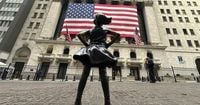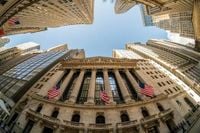Wall Street has rarely looked so buoyant. On September 4, 2025, U.S. stock markets soared to record highs, fueled by growing investor optimism that the Federal Reserve is poised to cut interest rates later this month. Despite a string of weaker-than-expected labor market reports, traders embraced the soft data, betting that it would finally prompt the central bank to ease monetary policy—a move they’ve been anticipating for months.
The S&P 500 closed at an all-time high of 6,502.08, up 53.82 points or 0.83%, according to Barchart.com and Reuters. The Dow Jones Industrial Average climbed 350.06 points, or 0.77%, to finish at 45,621.29, while the Nasdaq Composite gained 209.97 points, or 0.98%, ending the day at 21,707.69. The Nasdaq 100 Index, a barometer for tech and growth stocks, also advanced by 0.93% to 23,633.01.
What sparked this rally? The answer lies in the numbers coming out of the labor market. The ADP National Employment Report, released Thursday, showed that U.S. private employers added just 54,000 jobs in August—a sharp drop from July’s 106,000 and well below the 65,000 median forecast. As Benzinga noted, this was a clear sign of a cooling labor market, and it sent a powerful signal to Wall Street: the Fed now has cover to cut rates without stoking fears of runaway inflation.
Investors responded in kind. "The labor market data we’re going to get—payrolls—tomorrow I don’t see really changing anything significantly because (Fed Chair Jerome) Powell has effectively already told us we’re getting a cut unless it’s really, really out of bounds," said Mike Dickson, head of research and quantitative strategies at Horizon Investments, in a comment to Reuters. Traders priced in a nearly 100% probability that the Federal Reserve would cut interest rates by 25 basis points at its next meeting on September 17, with odds for a second cut before year-end climbing to 90%, according to CME’s FedWatch Tool cited by Benzinga and Bloomberg.
It’s a classic case of bad news being good news for Wall Street. Instead of panicking over the weak jobs data, traders saw it as “soft enough for the Fed to act, but not bad enough to scream recession,” as Bloomberg put it. Even with the U.S. running on surging debt and deficits, and with growing political pressure on the Federal Reserve, the Treasury market has held firm. The 10-year yield has dropped more than a third of a point this year, beating every other major bond market globally. Bond volatility is near a three-year low, a sign that investors aren’t spooked—at least not yet.
Ed Yardeni, founder of Yardeni Research and the man who coined the term “bond vigilantes,” told Bloomberg, “The bond market has been calm.” He added that, despite heavy fiscal overhang and political meddling, the U.S. still “does stand out as remarkably stable.” But Yardeni also warned that the calm could be fleeting. “Bond vigilantes are in Europe and Japan,” he said. “They are out there, just not here. That could change pretty quickly.”
On the equities front, the rally was broad-based but especially pronounced in growth-sensitive and consumer discretionary sectors. The Consumer Discretionary Select Sector SPDR Fund (XLY) surged 1.3%, while the Utilities Select Sector SPDR Fund (XLU) lagged, down 0.4%. American Eagle Outfitters was one of the day’s biggest winners, rocketing 38% after forecasting third-quarter comparable sales above estimates, as reported by Reuters. Amazon shares also soared, jumping 4.3% after announcing that JetBlue Airways would be using its Project Kuiper low Earth orbit satellite system to provide free in-flight Wi-Fi—an innovation that could reshape the airline internet experience.
Other notable gainers included Broadcom, up 1.2% ahead of a strong quarterly revenue forecast, and Meta Platforms, which climbed 1.6%. T. Rowe Price Group (+5.96%), Western Digital Corp. (+4.38%), Williams-Sonoma (+4.32%), and Builders FirstSource (+3.53%) also featured among the S&P 500’s top performers, according to Benzinga. On the flip side, Salesforce Inc. tumbled 4.9% after forecasting third-quarter revenue below Wall Street estimates, while The AES Corporation (-6.61%), Centene Corporation (-5.64%), NiSource Inc. (-5.35%), and Molina Healthcare Inc. (-4.22%) rounded out the day’s biggest losers.
Even as stocks climbed, safe-haven assets lost their shine. Gold slipped 0.2% to $3,550, snapping a seven-day winning streak, and Bitcoin dropped over 2% to below $110,000, according to Benzinga. The appetite for risk was back in full force, with investors betting that easier monetary policy would keep the bull market running.
Yet, not everyone is convinced the party will last. September is historically a weak month for stocks, with the S&P 500 losing 1.5% on average since 2000, according to LSEG data cited by Reuters. And while AI-linked companies like Broadcom and Nvidia have driven much of the market’s gains in recent years, their momentum slowed last month amid trade uncertainties and shifting forecasts.
Behind the scenes, some experts are already bracing for potential turbulence. Stephen Jen, chief executive at Eurizon SLJ Capital, told Bloomberg that "the next pressure may be on QE, and if I were in the Trump administration, I would just put pressure on the Fed to consider re-adopting it." William Dudley, former New York Fed President, echoed those concerns, warning that the markets might be “a little too comfortable, given the fact of the president trying so hard to influence monetary policy.”
As for the Federal Reserve, its current policy of quantitative tightening—letting up to $5 billion in Treasuries and $35 billion in mortgage debt mature each month without reinvesting—could shift if economic conditions worsen. Pimco’s Michael Cudzil suggested the Fed might start reinvesting maturing mortgage-backed securities to cool off housing markets, but for now, the central bank is holding its ground.
With advancing issues outnumbering decliners by a 2.79-to-1 ratio on the NYSE, and more than 300 new highs recorded, the mood among investors is undeniably upbeat. But as Yardeni cautioned, unless Congress starts cutting spending or raising taxes, the U.S. may eventually lose the patience of investors—and when that happens, the consequences will be felt in the market, not in a press release.
For now, though, Wall Street is riding high, buoyed by the hope that a long-awaited rate cut is just around the corner. Whether that optimism proves justified—or short-lived—remains to be seen as the next round of economic data rolls in.

